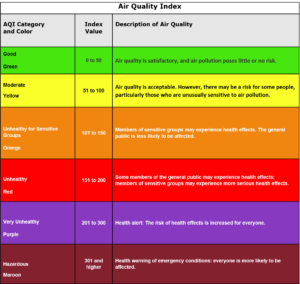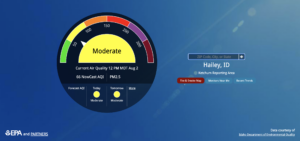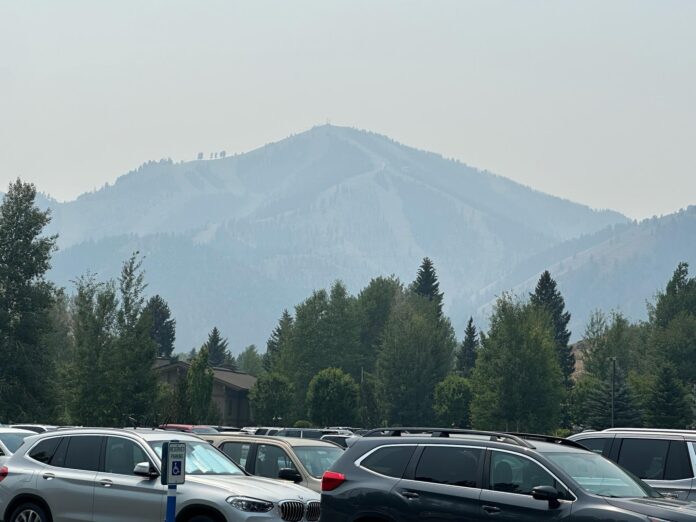Take a Deep Breath
BY ISAIAH FRIZZELL

We’re in the dog days of summer and wow are they intense. At this elevation it can feel as though you’re pressed right up against the sun. With extreme summers come wildfires and while we all know of the Bench Lake Fire at Redfish, as of this writing there are 14 large fires scattered across Idaho blazing into a veritable ‘Great Wall’ stretching from the Idaho/Oregon border, west, nearly to the sea. These, the usual summer heat and pollution, all add up to make big changes to the quality of air.
Wildland Fires

A wildland fire is one that “occurs in an area where there is little to no human activity or development.” That would be your forests, grasslands, shrublands, and wetlands. You can visualize these wildland fires at https://idsmoke.blogspot.com/ and see many more, currently, in surrounding Montana and Washington. Although the direction of atmospheric wind currents and streams play a role in the changing potency of pollutants, wildland fires can amass to degrade the quality of air we all breathe. The metric to gauge this is known as the Air Quality Index (AQI).
Healthy adults shouldn’t have much to worry about, but those who are pregnant, have small children, those with asthma, lung or heart disease can be impacted by the pollutants from a collection of wildland fires. To help better prepare for these incidents, the Environmental Protection Agency (EPA) and U.S. Forest Service have created the AirNow Fire and Smoke Map at https://fire.airnow.gov/ showing you precise conditions where the air may be healthy, harmful or somewhere in between.
Fiery Science
Every May, the EPA hosts an Air Quality Awareness Week and this year’s theme was “Knowing Your Air.” The Centers for Disease Control, National Aeronautics and Space Administration (NASA), U.S. Department of Energy, U.S. National Park Service, U.S. Fish & Wildlife Service, and U.S. Forest Service, along with tribal, local and state governments, pooled resources to educate the public about air quality.
The Interagency Wildland Fire Air Quality Response Program (IWFAQR) was formed and at https://outlooks.airfire.org/outlook you can find, updated in near real time, Smoke Outlooks, which are collections of where smoke from fires could become a health issue. At https://www.airnow.gov/aqi/ you will find resources and a heatmap with the “AQI Basics for Ozone and Particle Pollution.” The AQI is color coded into six zones starting at green with an AQI of 0-50m, which poses no risk, and progressing to maroon with an AQI of 300+, which becomes a health warning for absolutely everyone. But what exactly is being measured?
“The EPA establishes an AQI for five major air pollutants regulated by the Clean Air Act. Each of these pollutants has a national air quality standard set by the EPA to protect public health: ground-level ozone, particle pollution (also known as particulate matter, including PM2.5 and PM10), carbon monoxide, sulfur dioxide, nitrogen dioxide” (https://www.airnow.gov/aqi/aqi-basics/).
You can think of the AQI as an easily read metric for how you’ll be impacted in the zone you’re looking for. They use temporary monitors and nearly 15,000 low-cost sensors to measure fine-particle pollution, which is the most deleterious pollutant in smoke. These sensors are placed near smoke plumes to provide near real-time updates on the AQI.
Minding The Children
Fine-particle pollution can be in the air whether you see it or not. Children often find it challenging to understand things they can’t immediately see. To address this, AirNow has created a children’s book called “Why Is Coco Red?” (https://www.airnow.gov/education/why-is-coco-red/) that aims to explain, visually, how these fire-based pollutants can cause lung issues during times of poor AQI.
Runny nose, burning eyes and symptoms of bronchitis can be an early warning and for the asthmatic, the symptoms include heavy coughing and painful breathing. There are steps you can take to protect yourself in all zones but the most common sense is to leave the zone if it’s at AQI 101 or beyond. Most Idahoans, knowing the dangers of fire season and increased traffic pollution from population growth, have air filters in home and modern smoke detectors typically offer carbon dioxide and monoxide sensors. There are a whole range of new air-quality sensors worth searching for at your nearest hardware store or online mercantile.
Passion for the Great Outdoors
We all love to get out during the summer but along with sunscreen, shades and water, it’s a good idea to check the air quality in your neighborhood or near your next daycation, especially if you have loved ones in tow with sensitive lungs.
According to Amy Dillon, public information officer for the South Central Public Health District, “The AQI in Ketchum, which is the closest monitoring station, is at 61, and that’s a good thing. Currently, the region is at the ‘Moderate’ level, in the yellow. This is an improvement compared to the last two to three weeks, where the AQI index ranged between ‘Unhealthy for Sensitive Groups’ and ‘Unhealthy’ in South Central Idaho.
“Anything at 101 AQI and above is unhealthy, especially to sensitive groups. These groups can include people with lung diseases, such as asthma, people with heart disease or diabetes, children and teens, those who are pregnant, older adults, and people who are active outdoors.
“To stay safe when air quality is unhealthy, people should limit the time they spend outdoors, reduce the intensity of any outdoor activity when they are outdoors, take more breaks, and keep any rescue inhalers close by, where applicable. People are encouraged to spend time indoors in filtered-air environments, and to replace any air filters as needed.
“To sensitive groups, it’s recommended to make outdoor activities shorter and less intense. It can be OK to be active outdoors, but take more breaks. Watch for symptoms such as coughing or shortness of breath.
“People with asthma: Follow your asthma action plan and keep quick relief medicine handy.
“People with heart disease: Symptoms such as palpitations, shortness of breath, chest pain, or unusual fatigue may indicate a serious problem. If you have any of these, you definitely want to contact your healthcare provider.
“And, of course, stay updated on air-quality reports from the smoke maps.”
There’s An App For That
To make things even easier, you can download their mobile app at https://www.airnow.gov/airnow-mobile-app/. This app offers a smart routine check before traveling during this most heat-beleaguered season.



